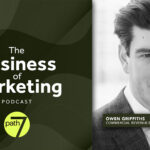By Chris Wickson, VP & GM, EMEA and Event Lead Management at Integrate
If there’s anything certain about today’s world, it’s that it’s uncertain. And in the world of B2B, nowhere is that uncertainty more well-founded than in B2B events. For one, we need to recognize that how, when and where we do events is constantly shifting. Not only are there ever-evolving COVID guidelines across geographies, but there are also varying levels of readiness for face-to-face interactions. This means that the new events landscape is much more than dinners, conferences, and webinars; it now spans short, on-demand webinar content and small, regional gatherings, to multi-day hybrid experiences and the return of major trade shows.
So how do we manage and unite this dizzying array of event experiences? We need to consider a holistic event strategy that connects in-person and digital channels and overlays with our entire demand strategy.
- Target the right buyers or accounts with personalized experiences
Marketers need to plan and execute events as one touchpoint of many on our buyer’s journey to purchase. Before any event planning takes place, marketers need to work with their sales teams to identify and target key buyers and accounts across channels. This then serves as the foundation for you to drive attendance to first-party events or engagement at third-party shows.
But don’t just upload a list of leads to Marketo and call it a day. Meet buyers where they are with multi-channel campaigns to deliver a consistent, connected experience pre-and post-event. Leverage digital channels to increase attendance and engagement. Consider how you can use digital channels to get greater longevity out of your event content.
- Activate leads to create omnichannel digital experiences
Events are powerful touchpoints and create opportunities to meet buyers across all stages on the path to purchase. Buyers at your events may just be conducting research or they may be ready to talk to sales. Regardless of where they are on their journey, consider how you are creating digital touchpoints before and after events based on their level of readiness. Make sure you capture the context of any event interaction to determine buyer readiness. Consider how to leverage existing content and digital channels to create follow-up experiences beyond just email. And be sure to prioritize active in-market accounts and provide high-touch, near-real-time experiences.
- Connect your teams and data to orchestrate the buyer experience
Events can no longer exist in a silo. Work closely with demand and marketing ops to incorporate all channels into your strategy so you can take a cross-functional approach to reach the right buyers wherever they are. For instance, for your own, first-party events, consider tools that allow you control of the entire attendee management flow from pre-event registration to on-site check-in to post-event management. And for sponsored, third-party events, use a universal event lead management solution that connects your event data to the rest of your martech stack. Connected data is important for creating a single real-time view of the buyer so you can have a full picture of the buyer’s journey and can meet buyers where they are, with experiences and messaging that corresponds to their level of readiness.
- Govern your data to ensure it is marketable and compliant
The quality of your data is directly correlated to your ability to deliver a connected, personalized digital experience. If you have the wrong email address, how can you email your buyer? If you have the wrong company or industry information, how can you deliver a personalized, relevant message to your buyer? Inaccurate information makes data unmarketable, so it’s critical that your data across your virtual, hybrid and in-person events are governed to ensure standardization, validation, and compliance. Look for solutions that can capture information at your in-person events, virtual events, hybrid events, and webinars, and also ensure data quality and compliance before entry into your marketing automation or CRM system.
- Measure event performance and optimize future strategy and spend
Measurement, measurement, measurement. It’s a critical component to understanding and improving your event and broader B2B strategies. This means that you need to develop connected systems that are capable of tracking interactions across channels before, during and after events. Take for instance, a buyer who you met at a trade show, then attended one of your webinars, then downloaded your content via a third-party publisher, and completed a demo request form on your website. All those touchpoints are important to capture, and together, you get important insight into their readiness to buy. You need to connect your lead capture, CRM and marketing automation systems to connect all that data so you can measure the impact of events on your new opportunities, renewal, and expansion revenue. Align your event metrics to event type and measure what matters.
The world we’re living in has changed and will continue to change. In the face of all this uncertainty, it’s important to be flexible and keep an open mind to new approaches. For B2B marketers, that means rethinking events and how they connect to broader demand and digital strategies. Events need to be more precise, connected and agile. It’s time that B2B events truly become part of the digital landscape.
Chris Wickson is VP & GM, EMEA and Event Lead Management at Integrate, an enterprise marketing software and solutions provider.






